How to Compress Image Size Online Free – Ultimate Guide
10/25/2025
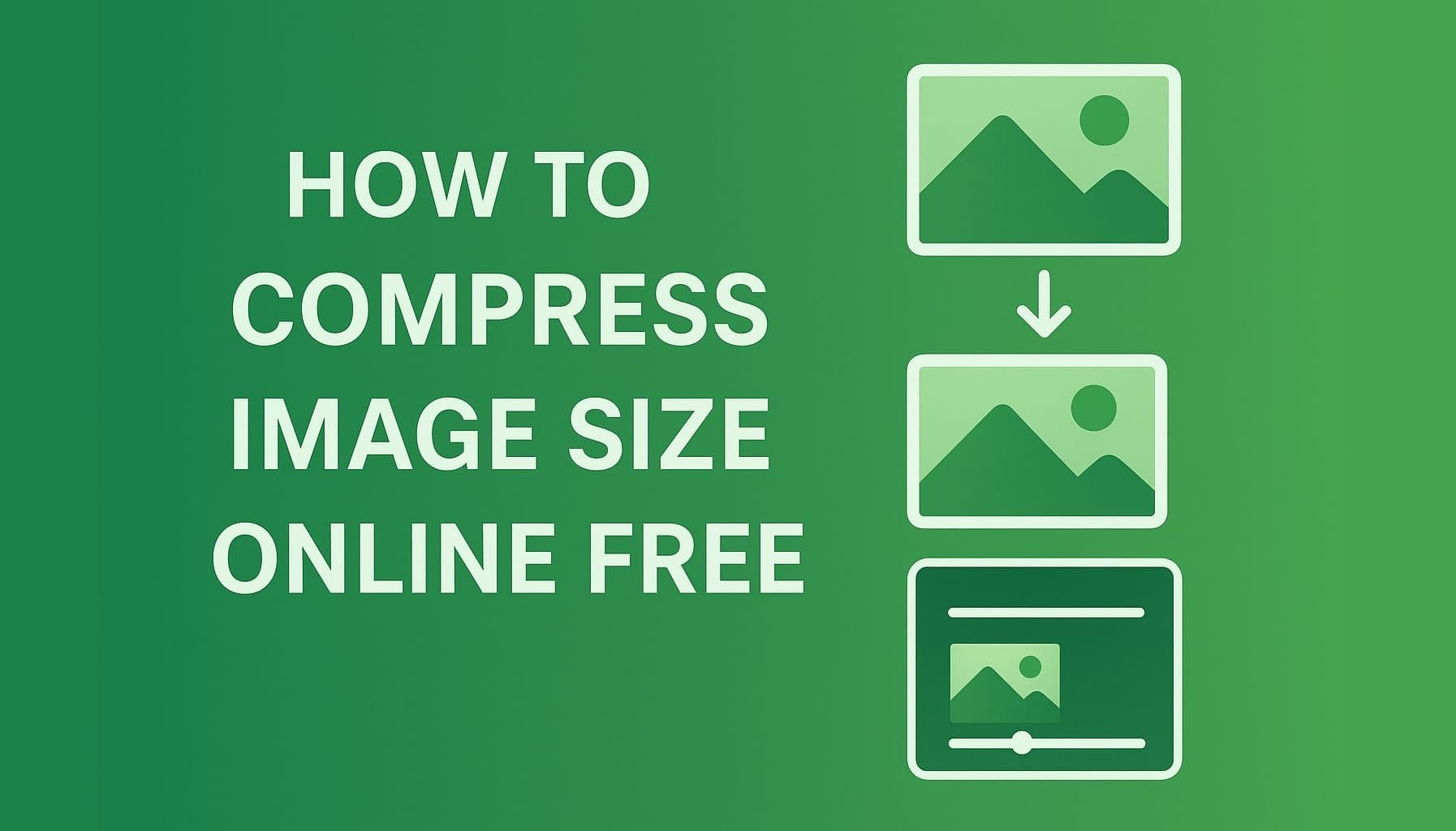
Introduction
Picture this: You've just finished designing a beautiful website. The layout is perfect, the content is engaging, and everything looks stunning on your screen. But when you test the loading speed, it crawls like a snail. The culprit? Massive, uncompressed images eating up bandwidth and frustrating your visitors.
Or maybe you're trying to email important photos to a client, but your email provider keeps rejecting them because the files are too large. Sound familiar?
In our image-heavy digital world, file size matters more than ever. Whether you're building a website, sharing photos on social media, sending documents via email, or just trying to free up storage space on your phone, knowing how to compress images properly is essential.
The good news? You don't need expensive software or technical expertise. With the right online tool, you can compress image sizes in seconds while maintaining excellent visual quality — and it won't cost you a penny.
In this comprehensive guide, we'll explore everything you need to know about image compression. You'll learn why it's important, how it works, and most importantly, how to compress your images effectively using ImageToolo's powerful free compressor. By the end, you'll be saving gigabytes of storage and dramatically improving your website's performance. Not sure which format to use? Check our guide on JPG vs PNG vs WEBP first.
Step-by-Step: Compress Image Size Using ImageToolo
Now let's walk through the actual compression process. ImageToolo makes this ridiculously simple, but I'll give you the full picture so you understand what's happening at each stage.
🌐 Step 1: Navigate to the Compressor
Open your web browser and go to ImageToolo Image Compressor. The interface loads instantly — no annoying ads, no registration walls, just a clean workspace ready for your images.
The tool works flawlessly on any device. Whether you're on a desktop computer, laptop, tablet, or smartphone, the experience is identical and optimized for your screen size.
📤 Step 2: Upload Your Images
Click the Upload Images button or drag and drop files directly into the upload zone. ImageToolo accepts all major formats: JPG, PNG, WEBP, GIF, and more. You can upload a single image or multiple files simultaneously for batch compression.
Here's what's happening behind the scenes: Your images upload through an encrypted connection. The tool immediately analyzes each file, detecting format, dimensions, current file size, and color profile. This analysis happens in milliseconds and guides the compression process.
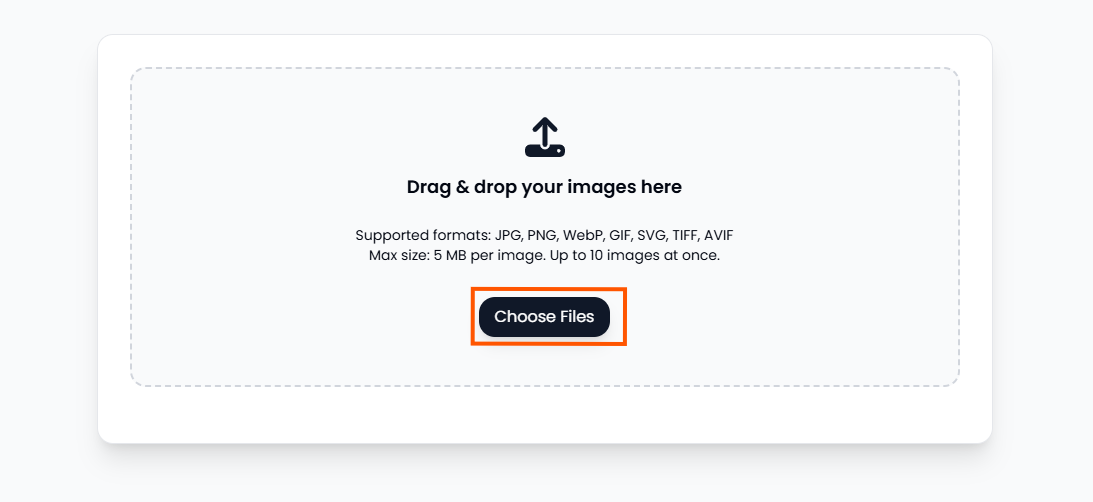
⚙️ Step 3: Choose Compression Level
This is where you take control. ImageToolo offers different compression levels to match your specific needs:
High Quality (Minimal Compression): Reduces file size by approximately 20-40% with zero visible quality loss. Perfect for professional photography, portfolio images, or anywhere visual perfection is paramount.
Balanced (Recommended): Achieves 50-70% file size reduction with negligible quality impact. This is the sweet spot for most users — maximum benefit with virtually no downside.
Maximum Compression: Squeezes files down by 70-90% for situations where file size is critical. There may be slight quality reduction, but for web thumbnails, social media, or high-compression scenarios, it's often imperceptible.
The interface shows a preview as you adjust settings, so you can visually confirm the result before finalizing compression.
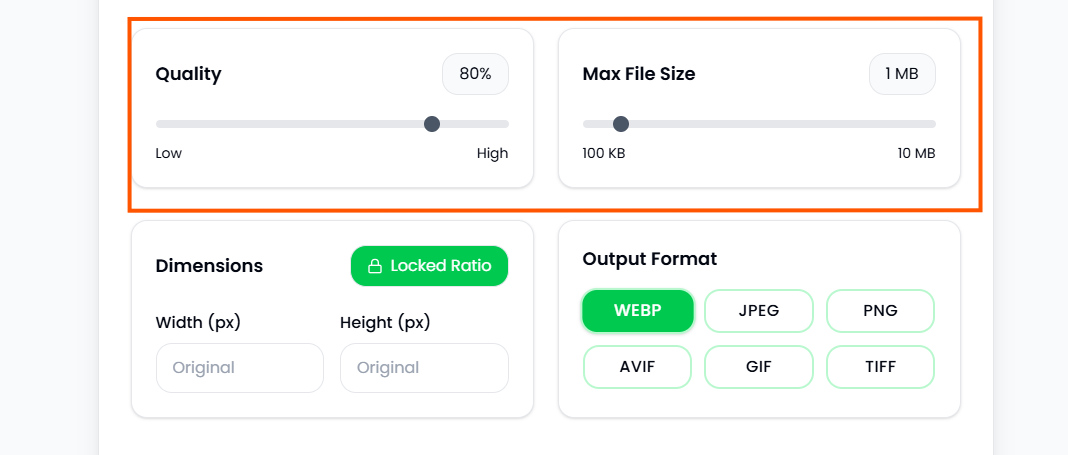
🎯 Step 4: Advanced Options (Optional)
Want more control? ImageToolo provides advanced options for power users:
Resize Simultaneously: Need smaller dimensions along with compression? You can resize and compress in one operation, saving time and maximizing file size reduction. For more precise resizing options, try our dedicated Image Resize tool.
Format Conversion: Compress and convert format simultaneously. This is incredibly useful for converting PNG to WEBP while compressing, achieving even greater size reductions. Need to change formats without compression? Use our dedicated Image Converter tool.
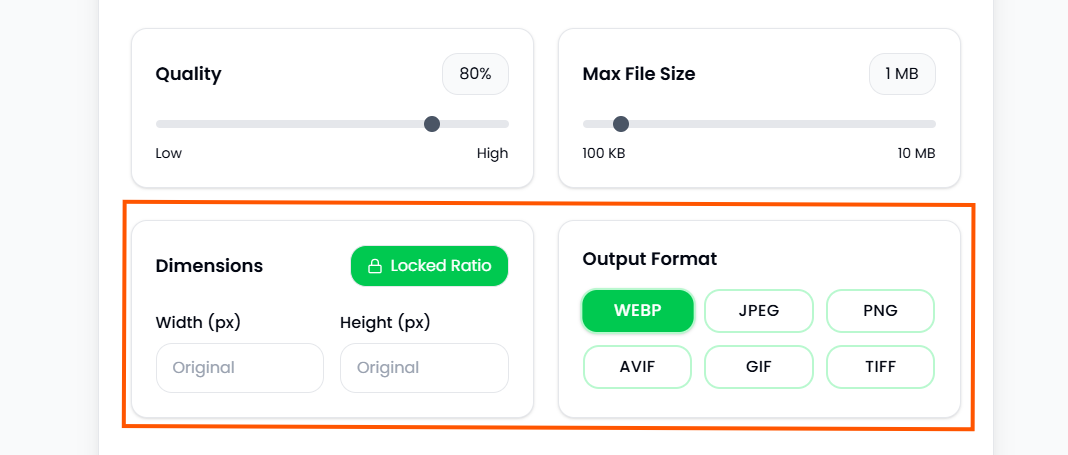
🔄 Step 5: Compress
Hit that Compress Images button and let the algorithms work their magic. ImageToolo's compression engine processes your images using advanced techniques that analyze each image individually and apply optimal compression strategies.
For most images, compression completes in 2-5 seconds. Larger files or batches might take 10-15 seconds, but you'll see a progress indicator keeping you informed.
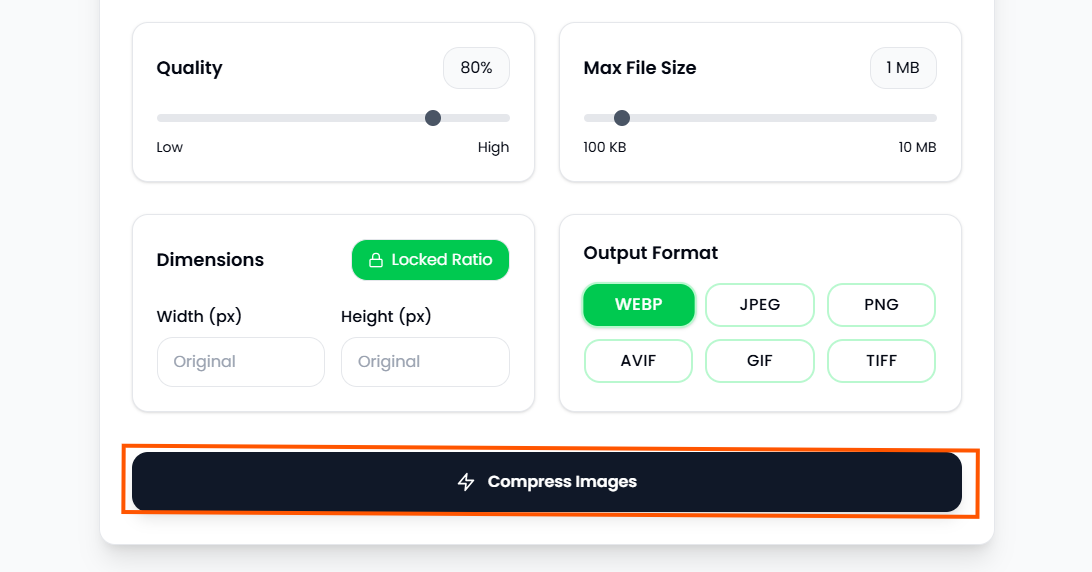
⬇️ Step 6: Download Compressed Images
Once compression finishes, you'll see a comparison showing original size versus compressed size. The savings are usually dramatic — often 70% or more.
Click Download to save your compressed images. For batch compressions, ImageToolo creates a convenient ZIP file containing all your compressed images, making downloads clean and organized.
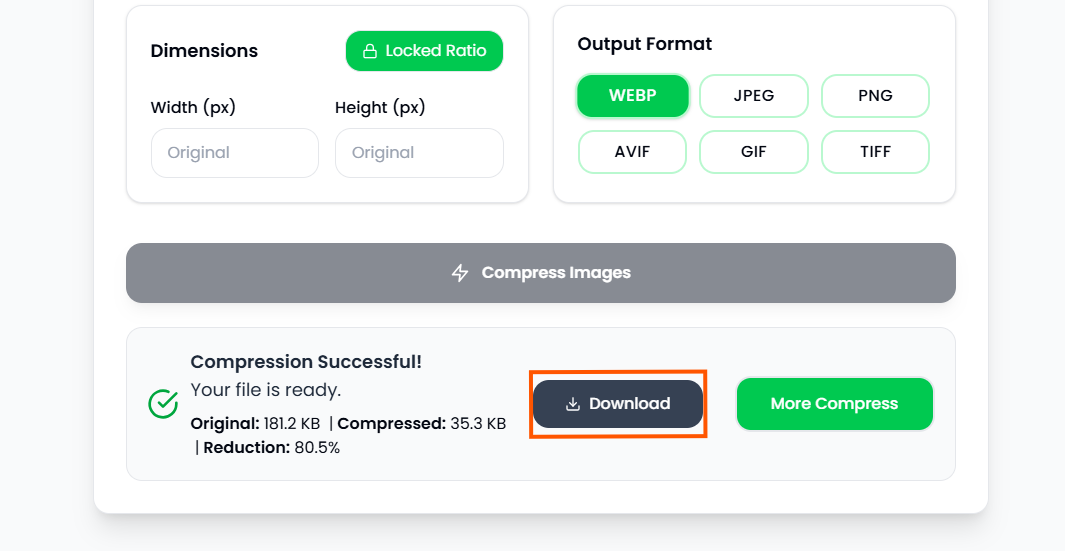
The best part? Your original images are automatically deleted from ImageToolo's servers after processing. No one stores copies, analyzes your content, or uses your images for any purpose.
What is Image Compression and Why Does It Matter?
Let's start with the basics. Image compression is the process of reducing an image file's size by removing or reorganizing data. Think of it like packing a suitcase — you're fitting the same items into less space through clever organization.
But here's what makes image compression special: unlike simply deleting parts of your image, good compression maintains the visual quality while dramatically reducing file size. It's not magic; it's mathematics and clever algorithms working together.
The Real Cost of Large Image Files
You might be wondering, "Why should I care about image size? Storage is cheap, and internet speeds are fast these days." Well, let me paint a clearer picture:
Website Performance: Google found that 53% of mobile users abandon sites that take longer than three seconds to load. If your site is packed with uncompressed images, you're literally watching potential customers leave before they even see your content. Every extra second of loading time can cost you up to 7% in conversions.
SEO Rankings: Google explicitly uses page speed as a ranking factor. Sites with compressed, optimized images load faster and rank higher in search results. Your competitors who compress their images are getting more organic traffic simply because their pages load quicker.
Storage Expenses: Cloud storage seems unlimited until you get the bill. Professional photographers, designers, and businesses storing thousands of images pay hundreds or thousands of dollars monthly for cloud storage. Compressing images can cut these costs by 60-80% without sacrificing usability.
User Experience: Mobile users on limited data plans appreciate lightweight pages. When someone in a rural area or developing country tries to view your content, compressed images mean they can actually access it without burning through their data allowance.
Email and Sharing: We've all tried to email photos only to hit size limits. Compressed images share easily across any platform without quality concerns or frustrating "file too large" errors.
Understanding the Two Types of Compression
Image compression isn't one-size-fits-all. There are two fundamental approaches, and understanding them helps you make better decisions:
Lossy Compression: Maximum Size Reduction
Lossy compression achieves smaller file sizes by permanently removing some image data. This sounds scary, but here's the thing: the removed data is usually imperceptible to human eyes.
When you save a photograph as a JPG, you're using lossy compression. The algorithm identifies subtle color variations and details that your eyes probably won't notice, then discards them. The result? Files that are 60-90% smaller with minimal visible quality loss.
Best for: Photographs, social media images, website backgrounds, marketing materials, and anywhere file size matters more than absolute perfection.
Not ideal for: Medical imaging, legal documents, graphics with text, or images that will be edited multiple times.
Lossless Compression: Zero Quality Loss
Lossless compression reorganizes data more efficiently without removing anything. It's like rewriting a sentence to be shorter without changing the meaning.
PNG compression is typically lossless. The file shrinks, but every single pixel remains exactly as it was. When you decompress the image, it's bit-for-bit identical to the original.
Best for: Logos, graphics with sharp edges, images with text, screenshots, technical diagrams, and any image requiring pixel-perfect accuracy.
Trade-off: File size reduction is modest compared to lossy compression — usually 10-30% rather than 60-90%.
How Image Compression Actually Works
You don't need to be a computer scientist to use compression tools, but understanding the basic principles helps you get better results.
Color Reduction
Human eyes can distinguish millions of colors, but most images don't actually need that many. Compression algorithms analyze your image and reduce the color palette to only the colors actually present. A photograph might use 16 million possible colors but only contain 50,000 unique shades. Storing information for only those 50,000 saves significant space.
Pattern Recognition
Images contain lots of repetition. A blue sky is essentially the same blue repeated thousands of times. Instead of storing each pixel individually, compression algorithms say "repeat this blue 5,000 times" — storing far less data.
Metadata Removal
Images carry hidden data: camera settings, GPS coordinates, software information, color profiles, and more. For most uses, this metadata is unnecessary. Removing it can cut 10-20% off file size without affecting the visible image at all.
Smart Algorithms
Modern compression tools use sophisticated algorithms that analyze your specific image and apply the optimal compression strategy. They identify which areas need detail preservation (like faces) and which can be compressed more aggressively (like out-of-focus backgrounds).
Why ImageToolo's Compressor Stands Out
The internet is full of image compressors, so what makes ImageToolo different? Let's break down the features that matter:
✨ Smart Compression Technology
ImageToolo doesn't use generic one-size-fits-all compression. Its algorithms analyze each image individually — identifying faces, text, gradients, and patterns — then applies customized compression that preserves what matters most.
🚀 Blazing Fast Processing
Time is valuable. ImageToolo's optimized compression engine handles images in seconds, not minutes. Even batch processing hundreds of images happens faster than you'd expect.
🔒 Privacy-Focused Design
Your images are your business. ImageToolo doesn't require accounts, doesn't track your uploads, doesn't store copies of your images, and doesn't use your content for anything beyond compression. Files are automatically purged after processing.
📱 Universal Compatibility
Windows, Mac, Linux, iOS, Android, ChromeOS — if it runs a modern web browser, it runs ImageToolo perfectly. No installations, no updates, no compatibility headaches.
💎 Zero Watermarks
Many free compressors slap ugly watermarks on your compressed images, essentially holding them hostage unless you pay. ImageToolo never watermarks anything. Your compressed images are completely clean and ready to use immediately.
🎨 Quality Preservation
The sophisticated compression algorithms prioritize visual quality. Most users can't distinguish between originals and compressed versions, even at significant file size reductions.
📦 Batch Processing Power
Need to compress 100 wedding photos? Upload them all at once. ImageToolo handles batch compression effortlessly, saving you hours of repetitive work.
🆓 Completely Free Forever
No trials, no premium tiers, no hidden costs. Every feature is available to every user, with no limits or restrictions.
Advanced Compression Strategies for Best Results
Want to squeeze every possible byte out of your images while maintaining quality? Follow these professional techniques:
Match Compression to Content Type
Not all images need the same approach. Photographs with complex colors and gradients can handle aggressive compression. Graphics with sharp edges and text need gentler compression to avoid visible artifacts.
Consider Final Use Case
Compressing for social media? You can be more aggressive since platforms will re-compress anyway. Compressing for print? Use minimal compression to preserve maximum detail.
Remove Unnecessary Metadata
Camera phones embed GPS coordinates, timestamps, device information, and more. This metadata adds 50-200KB to every image with zero visual benefit. Stripping it during compression is free file size reduction.
Optimize Before Uploading
If you're starting with a 5000x4000 pixel image but only need 1200x900 for web use, resize before compressing. Compressing smaller images is more efficient and produces better results than compressing huge images then scaling them down.
Use Progressive JPEGs for Web
Progressive JPEGs load gradually, showing a low-quality preview that sharpens as more data loads. This creates a better user experience on slower connections.
Batch Process Systematically
When compressing multiple images, organize them by type first. Compress photographs together with one setting, graphics together with another setting. This ensures optimal results for each category.
Compare Before Finalizing
Always view compressed images at actual size on the device where they'll be used. An image that looks perfect on a 27-inch monitor might reveal compression artifacts on a phone screen, or vice versa.
Keep Originals
Compression is permanent — you can't uncompress an image to recover lost data. Always keep your original uncompressed files as master copies, especially for important images you might need to re-edit or reuse later.
Common Compression Mistakes to Avoid
Even with great tools, certain mistakes can ruin your results. Here's what to watch out for:
Compressing Already-Compressed Images
Compressing a JPG, then compressing it again, then again multiplies quality loss. Each round of compression introduces new artifacts. Always compress from the original highest-quality source. If you're working with different formats, see our guides on converting between image formats and choosing the best image format for your needs.
Using Wrong Formats
Compressing PNG photographs doesn't make sense — convert to JPG first for much better results. Similarly, compressing logos and graphics as JPG introduces artifacts; use PNG compression instead.
Over-Compressing Critical Images
Your homepage hero image or product photos need to look stunning. Don't compress them so aggressively that quality suffers. Find the balance between file size and visual excellence.
Ignoring Dimension Requirements
If you need a specific image size for a platform, resize before compressing. Compressing a 4000px wide image then scaling it to 800px wastes compression efficiency.
Forgetting Mobile Testing
Compression artifacts that are invisible on large monitors become obvious on small, high-resolution phone screens. Always test compressed images on actual mobile devices.
Skipping Comparison Checks
View your compressed images side-by-side with originals before considering them final. Sometimes aggressive compression creates problems you'll only notice through direct comparison.
Real-World Impact of Image Compression
Let's look at concrete scenarios where compression makes a measurable difference:
E-Commerce Success Story
An online store had 50 product images per page, each around 2MB uncompressed. Total page weight: 100MB. Customers on mobile connections waited 45+ seconds for pages to load, and bounce rates were astronomical.
After compressing all images to WEBP at balanced quality settings, average image size dropped to 180KB. Page weight: 9MB. Load time: 3 seconds. The result? Bounce rate decreased by 40%, mobile conversions increased by 28%, and SEO rankings improved across the board.
Photography Portfolio Transformation
A professional photographer was paying $200 monthly for cloud storage hosting her portfolio of 10,000 high-resolution images. After compressing her archive using smart compression techniques, total storage dropped from 250GB to 65GB — cutting her monthly costs by 65% while maintaining professional visual quality.
Blogger's SEO Breakthrough
A food blogger published recipe tutorials with gorgeous photos, but her site ranked poorly and traffic was minimal. Google PageSpeed Insights showed her image-heavy pages loaded in 8-10 seconds.
After compressing all images and converting to WEBP, load times dropped to 2 seconds. Within two months, organic traffic tripled and Google rankings improved across dozens of keywords. The only change? Compressed images.
The Technical Side: How Compression Affects Different Formats
Understanding how compression interacts with different formats helps you make smarter decisions:
JPG Compression
JPG uses lossy compression by default. When you compress a JPG further, you're applying additional compression to already-compressed data. This works, but quality degrades faster than compressing from uncompressed sources. Quality settings between 75-85% typically provide excellent results.
PNG Compression
PNG is already compressed, but losslessly. Tools like ImageToolo can recompress PNGs more efficiently without any quality loss, typically achieving 10-30% size reduction. For even better results, consider converting photographs from PNG to JPG or WEBP.
WEBP Compression
WEBP is designed for optimal compression from the ground up. It supports both lossy and lossless compression and typically produces files 25-35% smaller than equivalent JPGs with no visible quality difference. Compressing to WEBP is almost always a win.
GIF Compression
GIF uses a limited color palette, so compression options are restricted. For animated GIFs, consider converting to video formats (MP4, WEBM) for dramatically better file sizes and quality.
Future of Image Compression
Image technology continues advancing rapidly. Here's what's coming:
AI-Powered Compression
Artificial intelligence is revolutionizing compression. AI algorithms can analyze images semantically — understanding what's important (like faces and text) and what's not (like blurred backgrounds) — and compress accordingly. This produces smaller files with better perceived quality than traditional algorithms.
Next-Generation Formats
AVIF and JPEG XL promise even better compression than WEBP, though browser support is still growing. These formats will likely become mainstream within the next few years, offering 30-50% better compression than current standards.
Progressive Enhancement
Future compression tools will generate multiple versions of each image optimized for different devices and connection speeds, automatically serving the best version to each user.
Final Thoughts
Image compression isn't just a technical optimization — it's an essential skill for anyone working with digital images in 2025. Whether you're building websites, managing social media, organizing photo libraries, or sending files to clients, knowing how to compress images effectively saves time, money, and frustration.
The key is using the right tool. ImageToolo's free image compressor combines powerful compression algorithms with an intuitive interface, delivering professional results without the learning curve or price tag of expensive software.
Remember the fundamentals: Use balanced compression for most images, match compression to content type, always keep original copies, and test results on actual devices. Follow these principles, and you'll consistently achieve excellent results.
Ready to start compressing? Head over to ImageToolo Image Compressor and experience the easiest, most effective way to reduce image file sizes online. It's fast, secure, powerful, and completely free. Check out our other popular tools for converting images, resizing, and adding watermarks to your compressed files.
Stop letting massive image files slow down your websites, eat up storage space, and complicate sharing. Take control of your images today and compress them to exactly the size you need, without sacrificing the quality you demand. Need more tips? Read our guide on the best image compressor online tools.
Your faster websites, happier users, and lower storage bills are just one compression away.